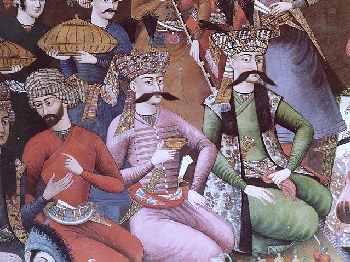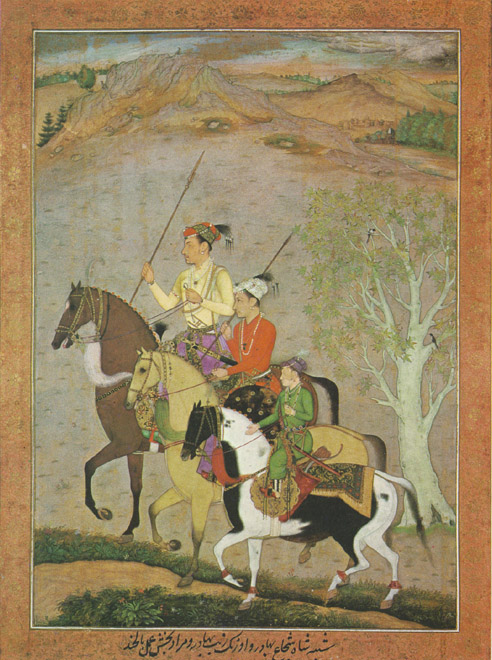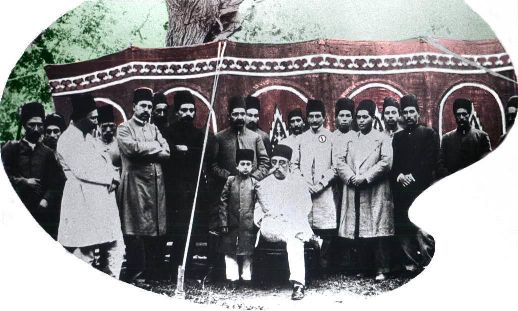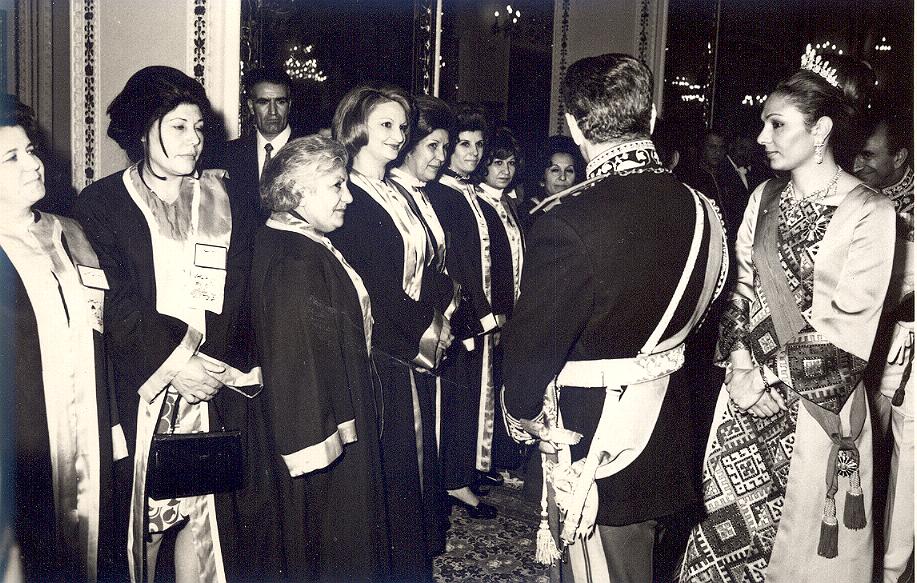A Brief History Of
The Hakimi Family
Foreword: In early 1980's or in and around the time of revolution in Iran, I was about 20 years old and studying for a degree in England. My best friend from high school in Teheran was also studying in England and from time to time I used to stay with him in London. He lived in a complex of apartments in the West End of London. At the time, there were quite a number of other Iranians living there. My friend had always been more impressed than I was with my mother's family pedigree. Soon as he learnt there was a Hakimi living there, he made his acquaintance and eventually introduced us.
I found Mr. Manouchehr Hakimi a slim, tall, white haired, elegant and very kind gentleman from Shiraz, the capital of the Pars (or Fars) Province in Iran. Shiraz is one of the oldest, famous and beautiful cities in Iran. A city where one of the main branches of Hakimi's established itself during the Qajar period owing to their association with the Prince Regent of the time, the infamous Mirza (Prince) Malek Mansour Shoja-ol-Saltaneh. It was customary for the Qajar Prince Regents to be appointed as Governors of Fars and its capital Shiraz was an important seat of government. Unknowingly M Hakimi started my interest in the family history by giving me a copy of a photo of Hakimis in attendance with the Qajar King Mozzafar-e-Din Shah during a state visit to England. On its back, the names of some of the Persian courtiers and politicians were written.
A few years later I was visiting Germany where my sister lives, my cousin from Norway happened to be visiting with his children, the fact that our children did not know each other, were missing the common thread that had bound our family together in Iran, was quite telling of life outside Iran. The above experiences motivated me to try and put this site together.
Although this was not meant to be an exhaustive history through the very kind help of Thomas Rochford (creator of the fantastic Isfahan site), Daee's old friend Mr. Karimzadeh Tabrizi who provided the material from Dr Honarfar's book (3), Auntie Fataneh, and Parviz Hakimi gave me the clues to research the most exciting story of the beginning of family fortunes which I have tried to narrate below and pages linked. I would have been completely stuck had it not been for Siamak Nikopoor's translation of the Arabic texts of the Hakim Mosque inscriptions. Many thanks also to Massoud Gharajehedaghi whose enthusiasm and support has been tremendous. A number of the pages would simply have not been possible without his contribution and Massoud has checked and rechecked all the pages. The work that we have put in this has been a labour of love and a pleasure. I have tried to design this pages with our children as the primary audience in mind.
Hamid, 21st September 2000, London
We can trace our ancestry back for
at least 350 years. In addition to historical references and documents recording the
contribution made by the more prominent members of the family to
Persian society, there is in Iran a detailed very well
documented family tree maintained by Parviz
Hakimi. There
is an abridged
version of the family tree and copies
of some of the documents mentioned above
available on this site.
To understand some aspects of our family history , let's start with the name, the word Hakim has two meanings, wise and physician or doctor. The ending i simply denotes belonging (in this instance a profession). It was customary in Persia to use one's family profession as part of one's name similar to other societies such as Smiths and Archers in England. Many generations of Hakimis were distinguished physicians and served in the courts of Persian kings. They were honoured and given the title Hakim-el-Molk or literally physician to the land or king.
In early twentieth century when western style surnames were adopted in Iran, they simply used their old family professional name Hakimi as a surname. The maternal influence was very strong, so much so that a number of the children chose their mothers' family name (for example my great grandfather was not a Hakimi yet my grand father and his siblings chose to be callled Hakimi).
 Using the above
family tree one can trace the Hakimis' beginning
to a 17th century physician called Mohammad
Davoud (David), his title was Hakim so as not to confuse him
with other Mohammad Davouds. He was physician to Shah (King) Safi I and Shah Abbas II of the Safavid dynasty,
rulers of Iran in the
seventeenth century. He lived in Isfahan: the
capital of Iran at that time. The
abridged tree starts with Mohammad Davoud
and Mirza
Hassan Hakim Bashi (Mirza and Bashi are
starting and ending titles, Mirza can mean both a Prince and
Mister, his name in English
would be written as Mr. Hassan, Chief
Physician) under Hassan's name it is written
that he was "fifth generation after Mohammad
Davoud Hakim Physician to Shah
Abbas II, and Founder Of the Hakim
Mosque". The Hakim
Mosque exists today and appears in
books about Persian monuments. For a
virtual tour of Isfahan and the Hakim Mosque
visit the Isfahan
website designed by Thomas C Rochford. The
information on the web page dedicated to the Hakim Mosque on the
Isfahan site pointed the way to finding out what we now know about Mohammad Davoud.
Using the above
family tree one can trace the Hakimis' beginning
to a 17th century physician called Mohammad
Davoud (David), his title was Hakim so as not to confuse him
with other Mohammad Davouds. He was physician to Shah (King) Safi I and Shah Abbas II of the Safavid dynasty,
rulers of Iran in the
seventeenth century. He lived in Isfahan: the
capital of Iran at that time. The
abridged tree starts with Mohammad Davoud
and Mirza
Hassan Hakim Bashi (Mirza and Bashi are
starting and ending titles, Mirza can mean both a Prince and
Mister, his name in English
would be written as Mr. Hassan, Chief
Physician) under Hassan's name it is written
that he was "fifth generation after Mohammad
Davoud Hakim Physician to Shah
Abbas II, and Founder Of the Hakim
Mosque". The Hakim
Mosque exists today and appears in
books about Persian monuments. For a
virtual tour of Isfahan and the Hakim Mosque
visit the Isfahan
website designed by Thomas C Rochford. The
information on the web page dedicated to the Hakim Mosque on the
Isfahan site pointed the way to finding out what we now know about Mohammad Davoud.
While living in India, Mohammad Davoud financed the building of the Hakim Mosque which was completed in 1662 on the site of an earlier 10th century mosque. Before going to India, Mohammad Davoud Hakim was a prominent member of the Safavid court in Iran. Mohammad Davoud had to leave the court of Shah Abbas II under mysterious circumstances and spent the rest of his life in India and in the court of the Truco-Persian rulers of India. He is mentioned in the writings of 17th century European travelers of the time, namely Sir John (Jean) Chardin a French traveller in Iran, Francois Bernier a French physician who traveled in mid 17th century India, and Manucci a Venetian who traveled and lived in India 3, 4 & 5 & 10. He became a prominent member of the court of the Mongol Emperor of India, Shah Jahan who built the famous Taj Mahal as a mausoleum for his beloved wife and then his son Aurengzeb, which allowed him to send funds to his family in Isfahan to build the mosque and preserve their status in society.
 Prior
to the rise of the English in India, the Persians occupied
very senior positions in the court of Indian
rulers. Persian was the official language of
the court and Persians often served as physicians, lord
chamberlins, administrators and chancellors. The picture of Aurangzeb above is an
Indian document currently in the British Museum (where
else?) yet it is a Persian miniature and the text at the
bottom is in Persian: "Shuja, Aurenzeb, and Murad
Baksh" - Shuja and Murad Baksh were his brothers. The
nobles in the court were referred to as Omara meaning
chieftans. Mohammad
Davoud Hakim is listed in the books about nobility of
India of this period.
Prior
to the rise of the English in India, the Persians occupied
very senior positions in the court of Indian
rulers. Persian was the official language of
the court and Persians often served as physicians, lord
chamberlins, administrators and chancellors. The picture of Aurangzeb above is an
Indian document currently in the British Museum (where
else?) yet it is a Persian miniature and the text at the
bottom is in Persian: "Shuja, Aurenzeb, and Murad
Baksh" - Shuja and Murad Baksh were his brothers. The
nobles in the court were referred to as Omara meaning
chieftans. Mohammad
Davoud Hakim is listed in the books about nobility of
India of this period.
In later periods other descendants of Mohammad Davoud became physicians to the court and their role as physicians to the court of Qajar (1770-1925) is well recorded. In those times it was quite usual for sons to follow in their fathers' footsteps and continue the family tradition. We have documented evidence of two Hakimi ancestors being given the title Hakim-el-Molk during the Qajar reign. They were Mirza Mahmoud Khan and Ebrahim Hakimi. They were uncle and nephew and since the both the same title this can cause confusion. Indeed Persian titles make study of history very confusing at times. Unlike Europe the noble families in the East, did not enjoy automatic hereditary rights as everything belonged to the king. Although a title would often pass from father to son, it was not a given right. Indeed sometimes the kings would remove a person's title who had either died or fallen out of favour and grant it to someone unrelated.
Hakimis
also beame involved in politics and held senior posts in various branches of
government and the military. Notable examples were: Mirza
Ali Naghi Hakim Bashi
physician to Mozzafar-e-din Shah (ruled 1896-1907)
when the latter was the crown prince, Mirza
Abolhassan Hakim Bashi
physician to the court of Qajars, Mirza Mahmoud Khan Hakim-el-Molk
(Ali Naghi's son) was physician to Mozzafar-e-Din Shah and Minister
of the Imperial Court. Mirza Mahmoud became one of the well known courtiers in
the 19th and early 20th centuries. His nephew who everyone
usually recognises as Hakim-el-Molk, Mirza
Ebrahim
(Abraham in English) Khan Hakim-el-Molk, or using his modern
name Ebrahim Hakimi
was one of
the founding fathers of democracy in Iran as he became one of the leaders of the
movement for constitutional monarchy in Iran. Before he became one of the
leaders of the 1906 revolution he worked behind the scenes to bring a peaceful
end to the revolution.
He made
sure the Shah was aware of the aims and feelings
of people thereby preventing the
reactionary members of the Qajar dynasty from
tainting the Shah's view of the constitutional
movement who believed wrongly that the ultimate aim of
the revolution was to overthrow the Qajars. It is
said that Ebrahim used to slip revolutionary
material (shab nameh) into Mozzafar-e-din Shah's
palace at night and place it under his
pillow. Ebrahim was elected to the first
parliament in 1907 and left the court after the death of
Mozzafar-e-Din Shah as he found the political atmosphere in the
Qajar Court stifling. He held numerous
ministerial posts, some times at very crucial
stages in the history of Iran. According to
historians he was brave, honest and a hard
working patriotic politician. It is very
hard for us to imagine the conditions of Iran in
the late 19th and early 20th century when
corruption and colonial interference was tearing
the country apart.
Mozzafar-e-din Shah's
palace at night and place it under his
pillow. Ebrahim was elected to the first
parliament in 1907 and left the court after the death of
Mozzafar-e-Din Shah as he found the political atmosphere in the
Qajar Court stifling. He held numerous
ministerial posts, some times at very crucial
stages in the history of Iran. According to
historians he was brave, honest and a hard
working patriotic politician. It is very
hard for us to imagine the conditions of Iran in
the late 19th and early 20th century when
corruption and colonial interference was tearing
the country apart.
In 1909 Ibrahim was one
of the leaders of the committee responsible for
restoration of constitutional monarchy and
running of the country after Mohammad Ali Shah's dethronement and
exile to Russia (1). Since he
had an impeccable reputation as a man of
integrity and honesty he was put in charge of
reforming the court and riding the court of all the
corrupt Qajar family courtiers. The young
Shah was
about 12 years
old. One of Ebrahim's first acts was to fire Sultan Ahmad
Shah's Russian Tutor (Lieutenant Smirnoff) who
was suspected of being a Russian spy (1 & 8). This
seemingly trivial act was in fact a very
courageous for its time, in those days Iran was centre stage for
'The Great Game' or the competition between two powerful
colonial powers, Russian and Britain. Iranian
ruling class and government had become for the most part subservient to
the two colonial powers and people in the
government rarely acted without first consulting the representatives of the great powers. In
fact the dimissal of Smirnoff caused a big diplomatic row with the Russian government.
The Russians insisted on Smirnoff's reinstatement, but the
revolutionary leaders remained resolute and supported Ebrahim's
decision. He
then established a school for the
young Shah with Iranian tutors and schoolmates(7). The tutors were prominent Iranian scholars such as Zoka-el-Molk
(Foroughi) who later during Reza Shah rejuvenated the Persian language by reintroducing
Persian vocabulary to replace Arabic vocabulary.
Ebrahim held many senior ministerial positions during the Qajar period and later under Mohammad Reza Shah Pahlavi. He had withdrawn from politics during the reign of Reza Shah. Toward the end of the Second World War, Ebrahim became prime minister of Iran three times during crucial stages of Iranian history. He and his peers from 1906 played an intricate game of playing the now three super powers (America, Britain and Soviet Russia) to keep Iran's independence. The independence of the country was seriously under threat in 1945 (1324) from the Russians. When he became prime minister, most of northern Iran was under Russian occupation and the Red Army had dug in 5 miles outside Teheran's gates with no intention of leaving. In contravention to the agreement made among the Allies, the Russians had illegally also occupied the North East and East of the country. He instructed the Foreign Minister in his cabinet - Anoshiravan Sepahbodi - to give written notice to the Allies to leave Iran as the Second World war had come to an end and there was no justification for the occupying troops to remain in Iran. His team brought one of the first complaints to the Security Council of the newly formed United Nations in London. This started a well recorded chapter in history of Iran (1).
My grandfather who I was
named after, Abdolhamid
Hakimi served in variety of senior
government positions and ministries as a career
civil servant. But that is a poor description for someone with
such a wide experience who occupied numerous roles all at the
forefront of Iranian modernisation before and after the second
world war. He either oversaw or
 was closely
involved in bringing major reforms such as: introduction of
standard Persian text books for schools in Iran, Project
Manager for the first Medical faculty in Iran (Teheran
University), English replacing French as a second language in
Iranian education system, and Land reform. As
a permanent
undersecretary in Ministry of Agriculture
implemented the plan to reform the feudal system of land
ownership in Iran as decreed by
Mohammad Reza Shah Pahlavi. Reform of the
ancient feudal structure was by far the biggest
reform in Iranian society since it changed at a
stroke thousands of years of feudal ownership of
agricultural land. The above reforms were
opposed not only by the landowners but by the
clergy as land bequeathed to the clergy for charity provided them with their financial base.
Another major reform was universal sufferage voting rights for
women which the clergy vehemently oppposed. The reforms
made the rift between the Pahlavi dynasty and the
clergy ever wider. Abdolhamid held liberal attitudes in all aspects
of life. My grandmother Nossrat Taslimi Moghadam, was among the first
women to shed the veil long before women's liberation as a
civil servant in the Ministry of Education and later became a magistrate.
She was a member of the women's
association.
was closely
involved in bringing major reforms such as: introduction of
standard Persian text books for schools in Iran, Project
Manager for the first Medical faculty in Iran (Teheran
University), English replacing French as a second language in
Iranian education system, and Land reform. As
a permanent
undersecretary in Ministry of Agriculture
implemented the plan to reform the feudal system of land
ownership in Iran as decreed by
Mohammad Reza Shah Pahlavi. Reform of the
ancient feudal structure was by far the biggest
reform in Iranian society since it changed at a
stroke thousands of years of feudal ownership of
agricultural land. The above reforms were
opposed not only by the landowners but by the
clergy as land bequeathed to the clergy for charity provided them with their financial base.
Another major reform was universal sufferage voting rights for
women which the clergy vehemently oppposed. The reforms
made the rift between the Pahlavi dynasty and the
clergy ever wider. Abdolhamid held liberal attitudes in all aspects
of life. My grandmother Nossrat Taslimi Moghadam, was among the first
women to shed the veil long before women's liberation as a
civil servant in the Ministry of Education and later became a magistrate.
She was a member of the women's
association.